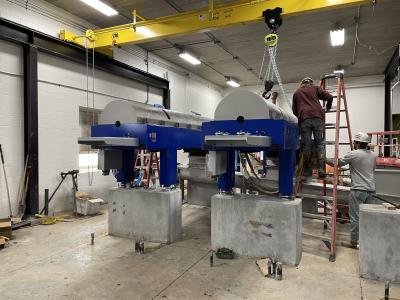
Project Status: In Progress
The City currently has one primary method of handling waste solids from the treatment process.
This is dewatering using a belt filter press. The existing solids processing equipment consists of one 2-meter Parkson belt filter press with a hydraulic throughput of 100 gallons per minute (GPM). In addition, there is a conveyor to the truck load-out facility and a polymer feed system.
The belt press was purchased secondhand several years ago and has experienced problems with the dewatering belt needing frequent replacement due to problems with misalignment of the belt and structural problems. With these issues, the belt press’s useful life has been exceeded and needs to be replaced. In addition, lack of functional sludge storage and lack of a redundant belt filter press create a vulnerable situation for any mechanical failures which cannot be resolved within 1-2 days.
Also, the capacity needed for future Sequencing Batch Reactor (SBR) solids generation will significantly increase. It was anticipated that a replacement system will be used for current operations and future SBR solids handling operations.
Most of the piping and valves in the building were also in dire need of repairs or replacement.
After a review of the 2018 Biosolids Dewatering Evaluation and discussion with City Staff, specific criteria and goals were determined for the new centrifuge dewatering system to meet the needs of the Wastewater Treatment Facility. These goals are listed below.
• Redundancy of major equipment
• Minimum flow rate of 100 GPM
• Minimum solids loading of 2000 lbs/hr
• Dewatered sludge solids of 28%-30% total solids
• Minimum solids capture of 95% total suspended solids
• Maximum polymer dosage of 12 active lbs/dry ton
City staff prefers to maintain a dewatering schedule similar to the existing one. To accomplish this, the facility needs a minimum capacity of 40 GPM and 850 lbs/hour initially.
A minimum of 2 parallel dewatering trains was recommended to build redundancy into the system.
For the future SBR process, a minimum capacity of 325 GPM and 1,300 lbs/hour was suggested to maintain a similar dewatering schedule to the existing. More truckloads of dewatered solids will need to be hauled during the SBR process, which will require more operator time. However, equipment run time will be similar to existing.



